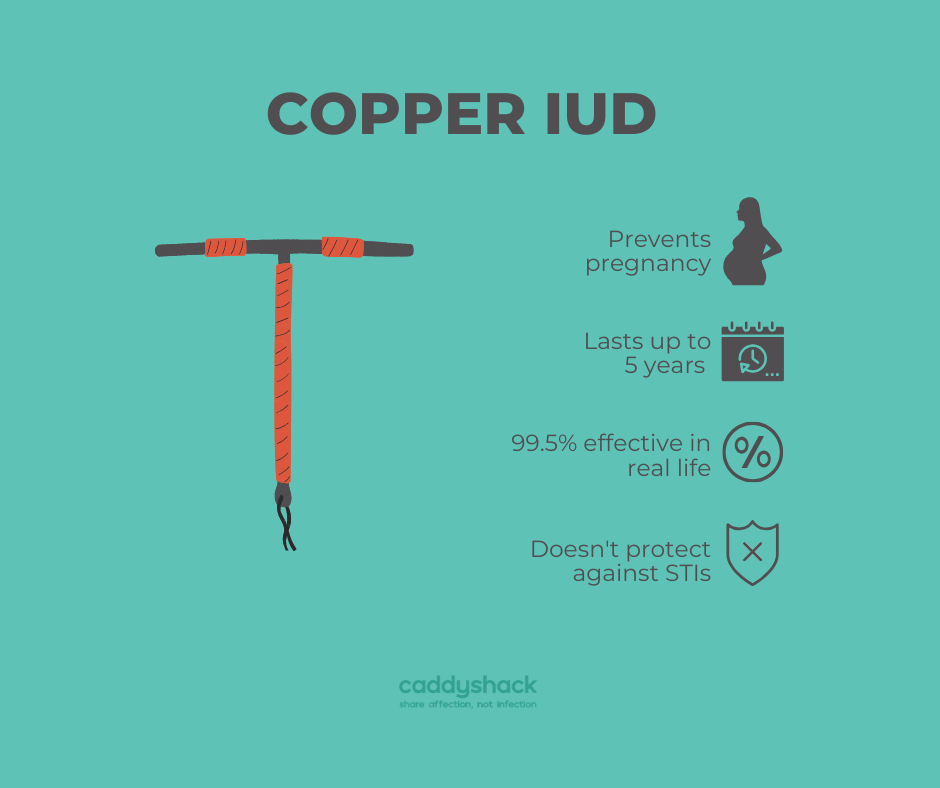Alternative Contraception Methods
July 30th 2020
Hi there Caddyshackers,
Welcome to our final blog post of our series on contraception methods.
Thanks for having me on your screens during July, it’s been fab! If you haven’t caught up on our previous contraception blogs on hormonal contraception and barrier protection - that’s okay, go check them out and we can meet you back here.
We have talked about both protection and hormonal contraception and the difference between the two.
FactFans: Using both a hormonal and barrier contraception method prevents unplanned pregnancy AND protects against Sexually Transmissible Infections (STIs) Yes please!
So now let’s get into all the other methods to prevent pregnancy. Alternative contraception methods don’t contact hormones. This can be great for people who choose not to use hormonal contraception because of health reasons, side effects, or based on their lifestyle and beliefs.
There are many non-hormonal or alternative contraception method options that are effective if used correctly.
Reminder: these do not provide protection from STIs. You guessed it - Condoms are the best protection!
Copper Intrauterine Device (IUD)
The Copper IUD is a device similar looking to the Mirena, however it is not hormonal.
This IUD is a copper wire and it works by changing the lining of the womb by making it a less suitable environment for a pregnancy.
Diaphragm
A Diaphragm is a silicone dome with a firm and flexible rim.
It is placed inside the vagina like a tampon so it covers the cervix (entrance into the uterus). It needs to be left there six hours after sex until the sperm in the vagina die.
It is cost effective and can be used if a partner is allergic to latex. Can be purchased from a chemist or online without a script. Plus the design has improved over the years so that you no longer need to be fitted by a health professional.
Withdrawal Method
The withdrawal method or Coitus Interruptus (for reals) is when a person withdraws their penis from the vagina before ejaculating.
It may be effective but it requires a lot of self-control and trust between partners. In the absence of any other contraceptive methods ‘pulling out’ is an often used as an alternative.
However, with the presence of pre cum, this can increase the possibility of becoming pregnant.
Fertility Awareness Methods
Let’s take look at natural cycles.
Fertility Awareness Methods (FAM) involve observing fertile signs such as cervical mucus secretions, cervical changes and basal body temperature also known as symptom based methods.
Other methods of natural fertility awareness based methods include monitoring the days of the menstrual cycle ‘calendar- based methods’.
Sperm has been shown to survive in the uterus or fallopian tubes for up to 5-7 days. The egg will survive for only 12-24 hours so a woman is most fertile in the week before ovulation (egg release) until a day after ovulation.
Advantages of this method include being cost effective and it does not interfere with the menstrual cycle.
Some disadvantages will require awareness of physical changes and may require periods of abstinence from sex.
It could also take between 3-6 cycles to accurately identify fertile days in a cycle.
Permanent methods
These last two methods are permanent and require a visit to the doctor.
Vasectomy
A Vasectomy (or The Snip) involves cutting and separating the vas deferens, which are the tubes that move sperm from the testicles to the penis.
Men can still enjoy sex and ejaculate, the only difference is that the semen does not contain sperm.
Please note, men will require a sperm count test after three months to ensure ejaculation is safe and another method of contraception will need to be used until then.
Tubal Ligation
Tubal ligation (getting your tubes tied) is an operation done under general anaesthetic. Generally one or two cuts are made in the abdomen, one at the belly button and one below the pubic hairline. A tiny telescope called a laparoscope is put in through one of the cuts so that the doctor can see the fallopian tubes. The tubes are closed with clips, rings or by cutting and tying.
It is considered 99.5% effective, however failures can happen even many years after the procedure. In the slight chance a woman becomes pregnant there is an increased chance of an ectopic pregnancy.
Confidence, Clarity & Contraception
Hope you enjoyed flicking through our contraception blogs this month. Just remember there are heaps of resources out there for contraception but an excellent place to start is with your doctor or women’s health nurse.
What we are loving right now
We are always loving Contraception.org.au a website run by Marie Stopes Australia where you can take the quiz to find your perfect contraceptive partner and find all the information you need.
Thanks for having me!
Peace, Love & Protection
x





